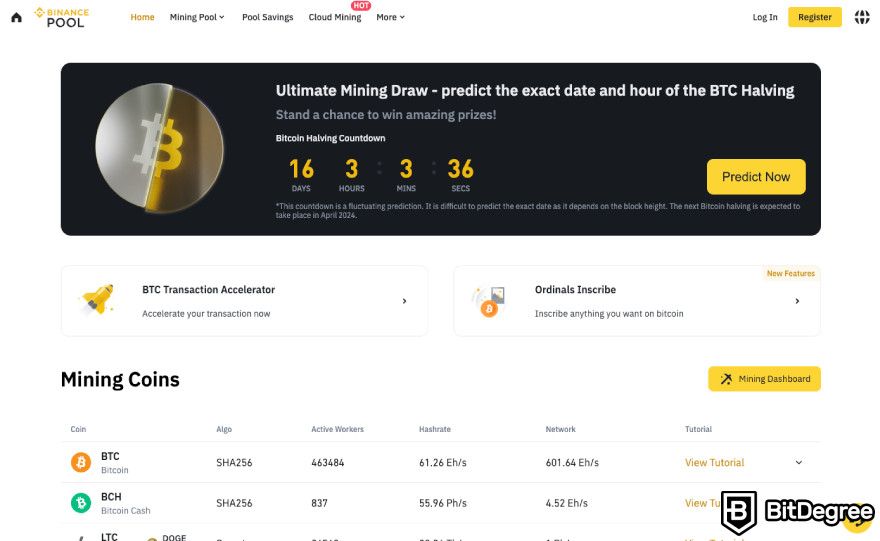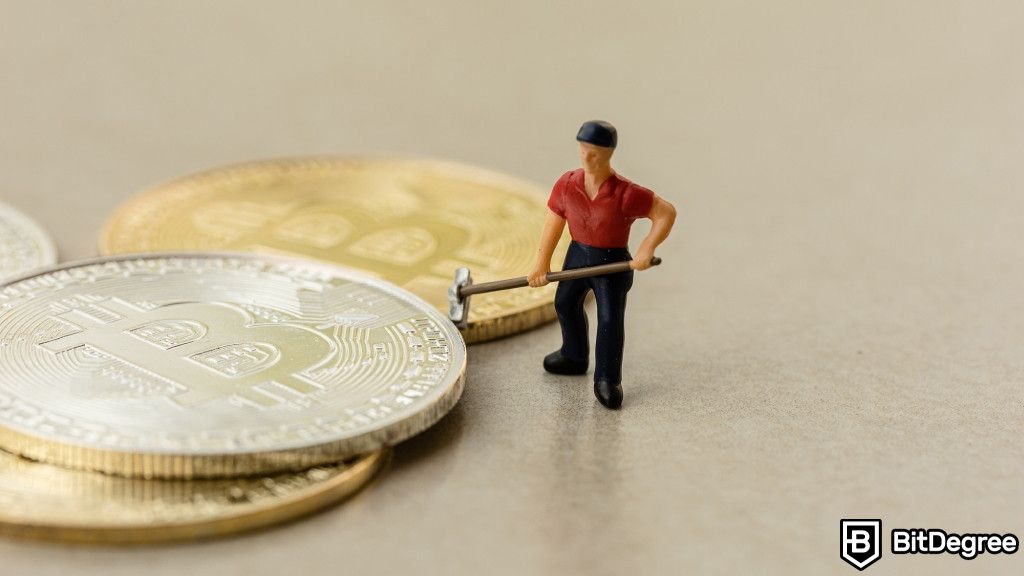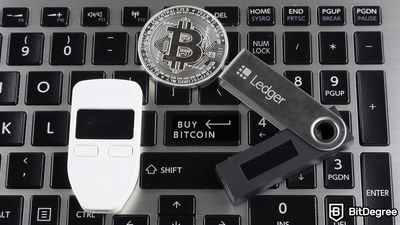Key Takeaways
- Crypto mining is the process by which new crypto enters into circulation, functioning as a critical component of the blockchain ledger's maintenance and development;
- Crypto mining involves solving complex computational tasks to validate and secure transactions, requiring significant energy and computational power;
- Crypto mining has significant economic implications, offering profit opportunities while also incurring substantial costs and necessitating considerable investment in hardware and energy.
Free Airdrop Season 7 is LIVE! Answer fun questions or do simple tasks to earn rewards from the $30K BitDegree prize pool. Participate Now ! 🔥
What is crypto mining, one might ask? It's the cornerstone of the cryptocurrency world, responsible for creating new digital coins and reinforcing transaction security.
As the crypto sphere grows, understanding mining becomes crucial for navigating its complexities. From the algorithms protecting blockchains to the heavy computational work defining mining, and the role of mining pools (like Binance's Bitcoin mining pool) in lightening the load, each element plays a vital role in sustaining the crypto ecosystem.
So, let’s navigate through the maze of crypto mining, dissecting its mechanisms and implications. This journey will reveal not just the technical gears of mining but also its economic footprints, offering a comprehensive overview of this digital gold rush.

Did you know?
Subscribe - We publish new crypto explainer videos every week!
Crypto Research Fundamentals: How to DYOR (Animated Explainer)


Table of Contents
- 1. What is Crypto Mining?
- 1.1. Cryptocurrency Mining Mechanisms
- 1.2. Pros and Cons of Crypto Mining
- 2. The Mining Process in Depth
- 2.1. Transactions, Blocks, and Validation
- 2.2. The Role of Miners and Mining Pools
- 2.3. Types of Crypto Mining
- 3. Economics of Mining
- 4. Environmental Concerns
- 4.1. Initiatives for Sustainability in Mining Operations
- 5. How to Mine Bitcoin?
- 6. Conclusions
What is Crypto Mining?
In the world of digital currencies, understanding what is crypto mining emerges as a pivotal process. This intricate procedure is essential for introducing new cryptocurrency units into circulation and maintaining the integrity of the blockchain, the underlying technology of these digital assets.
Latest Deal Active Right Now:Head to BitDegree Missions, gather as many Bits as possible & claim your stake of the $30,000 Prize Pool! Don't waste your time & start collecting Bits by completing Missions and referring friends.
The inception of mining is intricately tied to the origin of Bitcoin. Satoshi Nakamoto, the pseudonymous creator of Bitcoin, conceptualized a decentralized system for transaction verification, independent of traditional financial institutions, laying the groundwork for what is cryptocurrency mining.
This process is normally anchored in a system where miners employ computational power to solve cryptographic puzzles. Success in these puzzles results in the creation of a new block of transactions on the blockchain and, as a reward, miners receive newly minted coins. This dual role of coin creation and transaction validation is what maintains the blockchain's accuracy and trustworthiness.
In Bitcoin's early days, mining was very accessible, allowing individuals to participate with basic computing equipment. It was an enthusiast's domain, more about supporting a burgeoning financial system than profit. However, as cryptocurrencies gained popularity, mining evolved into a more complex and competitive field. This change was partly due to the increasing difficulty of mining puzzles, designed to maintain the network's stability and security.

The progression from a hobbyist activity to a professional enterprise led to the development of specialized mining hardware. To understand what is crypto mining in its current form, one must consider application-specific integrated circuits (ASICs), which were created, signifying a notable leap in both technological advancement and economic impact.
These machines are incredibly efficient but also expensive, creating entry barriers for individual miners and leading to the formation of mining pools (but more on that later).
With a clearer understanding of the role and evolution of crypto mining, let's now delve deeper into the technical mechanics behind it. This exploration will uncover the various methods and technologies that underpin and drive the mining process in the ever-evolving world of cryptocurrency.
Cryptocurrency Mining Mechanisms
The cornerstone of cryptocurrency mining is the consensus algorithm, a set of rules that governs the validation of transactions and the creation of new blocks on the blockchain. Understanding what is crypto mining, especially in the context of these algorithms, is vital for anyone delving into the cryptocurrency space.
Among the various consensus algorithms, Proof-of-Work (PoW) emerges as the most recognized, playing a pivotal role in networks such as Bitcoin. In PoW, mining crypto involves solving complex cryptographic puzzles using significant computational power. The process is competitive, with miners around the world rushing to solve the puzzle first and earn the mining reward.
PoW's design ensures a consistent rate of new block creation, crucial for the blockchain's stability and security[1].
Hash functions are vital in the mining process, too, transforming input data of any size into a fixed-size string of characters. This string serves as a unique identifier for a block of transactions. In their quest to secure the blockchain, miners work to find a hash that aligns with specific network criteria, thereby fortifying the blockchain's security and illustrating what is crypto mining at its core.

Beyond PoW, other consensus mechanisms like Proof-of-Stake (PoS) have gained prominence as well, introducing different ways for creating blocks. PoS allows coin holders to validate transactions based on the number of coins they stake. This method reduces energy consumption and hardware requirements, making it an attractive alternative.
Besides, in PoW, miners invest in powerful hardware and consume large amounts of electricity, whereas PoS requires significant holdings of the cryptocurrency in question and a focus on network participation. These different requirements have implications for who can realistically participate in mining (or staking) and under what conditions.
As the crypto world continues to evolve, these mechanisms remain at the forefront of technological innovation. They drive the development of new hardware and approaches, maintaining secure and efficient digital currencies. The future may see a blend of these mechanisms or the emergence of new ones as the community strives to balance efficiency, security, and environmental concerns.
Pros and Cons of Crypto Mining
Crypto mining presents a mix of benefits and challenges. Its role in maintaining and securing blockchain networks is undeniable, but it also brings with it a set of complexities.
Pros of Crypto Mining:
- Securing the Blockchain. One of the primary advantages of crypto mining is the security it provides to the blockchain. By validating transactions and creating new blocks, miners help prevent fraudulent activities such as double-spending.
- Generating New Cryptocurrency Units. Mining is the process through which new cryptocurrency units are introduced into circulation. This controlled release of new coins helps regulate the supply and can contribute to the overall value stability of the cryptocurrency.
- Incentivized Participation. For many, mining presents an opportunity to earn cryptocurrency without needing to invest directly in it. This incentivized participation in the blockchain network contributes to its growth and stability.
- Decentralization. Mining crypto contributes to the decentralization of the cryptocurrency network. By allowing multiple individuals and entities to participate in the mining process, it prevents centralization, which is crucial for maintaining the democratic ethos of cryptocurrencies. This aspect underscores what is crypto mining and its significance in preserving the foundational principles of blockchain technology.
Cons of Crypto Mining:
- High Energy Consumption. One of the most significant criticisms of crypto mining, particularly in PoW systems, is its high energy consumption. The computational power required for mining consumes a substantial amount of electricity, leading to concerns about its environmental impact.
- Market Volatility and Investment Risk. The profitability of mining is closely tied to market conditions. The volatile nature of crypto prices means that the return on mining investments can be unpredictable. Miners must navigate these market dynamics while contending with fixed costs like electricity and hardware, a challenge that underscores the importance of understanding what is cryptocurrency mining in relation to the broader economic landscape of crypto.
- Regulatory Uncertainties. The regulatory landscape for cryptocurrencies and mining is still evolving, with different countries adopting varied stances. This uncertainty can pose a risk for miners, as future regulations could impact the legality and profitability of mining operations.
While crypto mining plays a crucial role in the functioning of blockchain networks and offers opportunities for participation and reward, it also faces significant challenges. These include environmental concerns, market risks, and regulatory uncertainties.
The future of crypto mining may see shifts in practices and technologies as the industry continues to evolve, addressing these concerns while maintaining the benefits it provides to the cryptocurrency ecosystem.
The Mining Process in Depth
Understanding the mining process requires more than just a grasp of its role in the cryptocurrency ecosystem. It's a journey into what is crypto mining - a series of intricate steps that ensure the smooth functioning and security of digital currencies.
This process spans from the formation of individual transactions to their incorporation into the blockchain. Starting from how transactions are formed, to their grouping into blocks, and, ultimately, the validation that cements their place in the digital ledger.
Transactions, Blocks, and Validation
Every transaction in the cryptocurrency network marks the beginning of the mining process. These transactions, once initiated, are broadcast to the network and gathered into a block by miners. This is a fundamental part of what is cryptocurrency mining, involving thorough checks for authenticity and adherence to the network's protocols.
Miners then engage in the critical task of validating these transactions to ensure their legitimacy. This validation involves thorough checks for authenticity and adherence to the network's protocols. Once a block is validated and the correct cryptographic hash is found, it is added to the blockchain, establishing the permanence and irrefutability of those transactions.
The Role of Miners and Mining Pools
Miners play a dual role in the cryptocurrency landscape. Firstly, they are validators who ensure the authenticity of transactions. Secondly, they are creators of new blocks, a process that adds new coins to the system and rewards them for their efforts, embodying the essence of what is crypto mining.
As the difficulty of mining increased over time, the advent of mining pools became inevitable.
These pools are groups of miners who combine their computational resources to mine more efficiently. When a pool successfully mines a block, the reward is distributed among its members, proportionate to the computational power each contributed. This collective approach has become essential in an environment where solo mining is often no longer viable due to the high level of resources required.

Did you know?
Subscribe - We publish new crypto explainer videos every week!
What is Defi 2.0? (Explained with Animations)


Types of Crypto Mining
Crypto mining has diversified into various forms, adapting to technological advancements and individual preferences. The most prominent types include:
ASIC Mining
Using Application-Specific Integrated Circuits, this type of mining is highly efficient but involves a significant investment in specialized hardware.

ASICs are designed specifically for mining a particular cryptocurrency, making them powerful but less flexible.
GPU Mining
Utilizing Graphics Processing Units (GPUs), this form of mining crypto is popular among enthusiasts. GPUs are not as efficient as ASICs for mining purposes, but offer more versatility, as they can be used for mining various cryptocurrencies and other computational tasks.
Cloud Mining
This method allows individuals to participate in mining without owning or operating physical mining hardware. By renting mining power from a cloud mining service, users can mine cryptocurrencies remotely. This approach reduces the barriers to entry but comes with its risks, including lesser control of the mining process and the potential for scams.
CPU Mining
Once the standard, mining with the Central Processing Unit (CPU) of a computer is now largely obsolete for most major cryptocurrencies. It's less efficient than GPU and ASIC mining and is generally only viable for newer, less established cryptocurrencies.

Each type of mining comes with its set of advantages and limitations, shaping the choices of individuals and companies in the mining space. As the cryptocurrency market continues to mature, these mining methods may evolve further, reflecting changes in technology, market dynamics, and energy considerations.
Economics of Mining
The economics of crypto mining is a complex and multifaceted aspect of the cryptocurrency ecosystem, encompassing a range of financial considerations from initial investments to ongoing operational costs and profits. Asking, "What is crypto mining from an economic perspective?" becomes crucial for grasping its overall impact.
One of the primary economic considerations in mining is the initial investment required. This includes the cost of renting or purchasing and setting up mining hardware, which can add up to quite a hefty sum, especially for ASIC and high-end GPU setups.
Operational costs are another critical economic factor. Electricity consumption is the most significant ongoing expense for miners, as the process requires considerable computational power. The profitability of mining crypto operations is heavily dependent on electricity prices, which vary widely by geographical location.

This has led to the concentration of mining operations in regions with lower energy costs. Additionally, maintenance of the hardware and cooling systems to prevent overheating adds to operational expenses.
Now, revenue from mining comes primarily from two sources: block rewards and transaction fees. Block rewards refer to the new coins minted with each block creation. Nowadays, as part of the design of many cryptocurrencies, the block reward is programmed to halve at regular intervals (a.k.a. halving events).
For example, Bitcoin mining rewards started at 50 BTC, however, during the upcoming halving, it will be reduced to 3,125 BTC.
This gradual reduction of block rewards is intended to control the supply of new coins, mimicking the scarcity and value preservation similar to precious metals like gold. While this mechanism ensures a controlled supply, it also impacts the long-term profitability of mining, as the amount of rewards decreases over time.
Transaction fees, on the other hand, are paid by users to have their transactions included in a block. While these fees are generally smaller than block rewards, they have become an increasingly significant part of a miner's income. In networks with high transaction volumes, the cumulative total of these fees can be substantial.

Transaction fees are determined by the market, where users can typically choose how much they are willing to pay to have their transaction processed.
During times of high network congestion, users might opt to pay higher fees to prioritize their transactions, leading to a competitive market for transaction space within each block. As the fixed block reward continues to diminish over time, these fees are expected to constitute a larger portion of miners' revenue, aligning miners' economic incentives with the network's transaction processing and security needs.
The overall profitability of mining is influenced by various market factors, including the price of the cryptocurrency being mined, the total computational power of the network, and the difficulty of the mining process. These factors are particularly crucial when considering how to mine Bitcoin, as they directly affect the potential returns from Bitcoin mining operations.
Cryptocurrency mining may carry certain risks and uncertainties. The volatility of cryptocurrency prices can dramatically affect the value of rewards, making the return on investment unpredictable. Additionally, regulatory changes or technological shifts can render mining equipment obsolete or less profitable.
Environmental Concerns
The environmental impact of crypto mining has become a topic of significant debate, particularly in relation to its energy consumption and carbon footprint. Exploring what is crypto mining in this context addresses these concerns and explores the initiatives being undertaken to create a more sustainable mining ecosystem.
The energy consumption associated with PoW mining is a significant environmental concern[2]. As mentioned before, this mechanism demands extensive computational efforts and, consequently, substantial electricity usage. The resulting carbon footprint, especially if sourced from non-renewable energy, poses a challenge to environmental sustainability goals.
The impact of PoW mining has become even more analyzed as global awareness of climate change intensifies.
In response, the cryptocurrency industry is seeing a shift toward more energy-efficient mechanisms like PoS, and this evolution in mining practices is a key aspect of understanding what is cryptocurrency mining in the current era.

As you already know, PoS differs fundamentally from PoW in its approach to validating transactions and maintaining blockchain integrity. Instead of relying on energy-intensive mining operations, PoS selects validators based on the number of coins they hold and are willing to stake as security.
This method significantly reduces the need for high-powered computing, cutting down on the electricity required for mining activities. The lower energy demand inherently translates to a smaller carbon footprint, aligning more closely with global efforts to mitigate climate change. By prioritizing stake over computational power, PoS offers a more energy-efficient and environmentally conscious approach to maintaining blockchain networks.
The environmental benefits of PoS extend beyond just lower energy consumption. It also mitigates the need for the constant hardware upgrades that characterize PoW systems, where miners seek even more powerful equipment to stay competitive. This reduces electronic waste and the environmental impact associated with the production and disposal of mining hardware.
Furthermore, the energy efficiency of PoS makes it more accessible, potentially leading to a more decentralized and diverse group of validators.

- Secure and reliable
- Accepts fiat currencies
- Lots of trading options
- Reputable exchange
- Accepts fiat currencies
- Offers various trading options

- Fiat currencies - accepted
- Simple to use
- Accepts only the most trustworthy cryptocurrencies
- A leading cryptocurrency exchange platform
- Best for beginner investors
- Accepts fiat currencies

- Fully reserved and transparent
- Multiple tradable asset classes
- Over 300 supported cryptos
- Over 300 cryptocurrencies
- Secure & transparent
- Fully reserved
Initiatives for Sustainability in Mining Operations
However, in response to environmental concerns, several initiatives and innovations are being pursued to make crypto mining via PoW more sustainable, too:
Renewable Energy Sources
There's an increasing trend toward using renewable energy sources like solar, wind, and hydroelectric power for mining operations. This shift not only reduces the carbon footprint of mining but can also lower operational costs in the long term, making it a key factor in understanding what is crypto mining in the context of environmental sustainability.
Energy-Efficient Hardware
Advances in technology are leading to the development of more energy-efficient mining hardware. Newer models of ASICs and GPUs are being designed to provide more computational power with less energy consumption.
Heat Recovery
Innovative solutions are being implemented to repurpose the heat generated from mining operations.

This waste heat can be used for heating buildings or powering other industrial processes, thereby improving overall energy efficiency.
Geographic Diversification
Miners are exploring locations with cooler climates and access to renewable energy sources to set up their operations. This not only reduces the need for additional cooling systems but also taps into locally available sustainable energy.
Carbon Offset Programs
Some mining companies are investing in carbon offset programs to compensate for their environmental impact. These programs support renewable energy projects, reforestation, and other initiatives aimed at reducing carbon emissions.
The drive towards sustainability in crypto mining reflects a growing recognition of the need to balance technological advancement with environmental responsibility. As the industry continues to evolve, these initiatives are likely to play a crucial role in shaping the future of cryptocurrency mining, making it more compatible with global sustainability goals.
How to Mine Bitcoin?
Now, you should understand what is crypto mining, its pros and cons, its variations, and its environmental effects. However, you might not know yet how to actually engage in crypto mining. So, here's a comprehensive overview of Bitcoin mining (it's the pioneering minable cryptocurrency, after all):
Step 1: Understanding the Requirements
Before diving into mining, it’s crucial to understand the requirements. This includes not just the hardware and software needed but also an awareness of electricity costs, the current state of the Bitcoin network, and the initial financial outlay required for equipment.
Successful mining requires powerful hardware such as ASIC miners. These devices are specifically designed for mining Bitcoin and are much more efficient than prior methods.
Step 2: Selecting a Mining Pool
Due to the competitive nature of Bitcoin mining, it's almost impossible for an individual to mine successfully alone. Mining pools, where miners combine their computational power and share rewards, have become the norm.

Choosing the right mining pool involves considering factors like pool size, fee structure, and payout method.
Step 3: Setting Up a Bitcoin Wallet
Before starting to mine, you’ll need a Bitcoin wallet to receive and store your mining rewards. There are various types of wallets available, each with different features and levels of security. It's important to choose one that suits your needs and offers a good balance between convenience and security. Ledger Nano X, Zengo, and SafePal are a few noteworthy options.
Step 4: Installing Mining Software
Once you have your hardware and wallet, you'll need to install mining software. There are many different options available, each tailored to specific needs and hardware configurations. Choosing the right software is a crucial step in how to mine Bitcoin effectively.
Step 5: Configuring Your Mining Setup
After installing your mining software, you'll need to configure it to connect to your chosen mining pool and Bitcoin wallet.
This process will vary depending on the software and pool you’ve selected, but it typically involves entering specific information, such as your pool's address and port number, as well as your wallet address.
Step 6: Running Your Mining Operation
With everything set up, you can start mining. This will involve keeping your mining rig running smoothly, ensuring it's kept cool, and monitoring its performance. You'll also need to keep an eye on the Bitcoin market and your electricity costs to make sure your mining operation remains profitable.

The cryptocurrency world is fast-paced and constantly evolving, which is why staying informed about changes in technology, Bitcoin network difficulty, market prices, and legislation is very important. Also, being adaptable and willing to update or change your strategy is key to long-term success in Bitcoin mining.
Just note that while mining Bitcoin can be a rewarding venture, it requires a significant investment in time, money, and knowledge. The complexity and competition in Bitcoin mining have increased over the years, making it a challenging endeavor, especially for beginners.
However, for those willing to invest the necessary resources and continuously learn about the evolving landscape of how to mine Bitcoin, it can be an intriguing and potentially profitable pursuit.
Conclusions
So, what is crypto mining? As seen, this process is not just about creating digital assets but also about maintaining a secure and efficient network. Thus, it's important for the succesful functioning of blockchains, as well as major crypto platforms like Binance, Bybit, and Kraken.
The evolution of crypto mining from a simple, individual-based activity to a sophisticated, competitive industry mirrors the growth of the wider crypto sector. This change reflects the escalating significance of digital currencies in global finance, where mining is fundamental to the ecosystem's sustainability and efficiency.
Looking ahead, the future of crypto mining is poised for continued innovation and adaptation. Balancing efficiency, profitability, and environmental impact remains a key challenge. However, as the industry evolves, so too will the methods and impacts of crypto mining, shaping its role in the digital gold rush of our times.
The content published on this website is not aimed to give any kind of financial, investment, trading, or any other form of advice. BitDegree.org does not endorse or suggest you to buy, sell or hold any kind of cryptocurrency. Before making financial investment decisions, do consult your financial advisor.
Scientific References
1. T. T. A. Dinh, R. Liu, M. Zhang, et al.: 'Untangling Blockchain: A Data Processing View of Blockchain Systems';
2. S. Tayebi: 'The Flip Side of the Coin: Exploring the Environmental and Health Impacts of Proof-of-Work Cryptocurrency Mining'.













